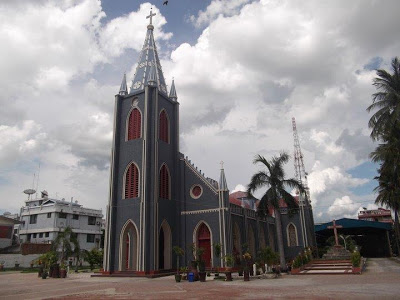
Mandalay is the second largest city in Myanmar, after the format capital, Yangon. Mandalay is remarkable for being at the heart of Burmese- Buddhist & Burmese culture. Catholic Christianity has always struggled to flourish in an environment that is so strongly Burmese and so strongly Buddhist. Even today the Archdiocese of Mandalay has only about 21,083 Catholics in an overall population of about 15 million people with 30182.93 square miles.
Even so, traces of Christianity in the greater Mandalay area can be traced back as far as the 1280’s. In Bagan, then a flourishing kingdom, there are frescoes containing crosses and some Latin and Greek words.
It was only in the 1500’s, with the opening up of trade between Europe, especially Portugal, and the various kingdoms of Myanmar, that Christians – both clerical and lay – began to arrive in ay numbers. Many of the present Catholics in Mandalay trace their heritage back to this period.
Successive generations of missionaries arrived, sometimes welcomed, sometimes rejected.
In the 1700’s it was mostly the Barnabite Priests who came to the Mandalay area. They were remarkably creative in their efforts to reach out to the local population, some of them excelling in their study of the Burmese Language and the religious language of Buddhism, Pali.
In the 1800’s there was brief period where the mission in the Mandalay area was entrusted to the Oblates of the Blessed Virgin Mary. By the mid-1800’s there was quite a strong French political influence around Mandalay. At the same time the Paris Foreign Mission Society (M.E.P) assumed responsibility for Mandalay area.
This French political and economic interest in the Mandalay area generally, and the royal court in particular, was one factor in the British invasion and annexation of Northern Burma in the 1850’s. For the British, Mandalay was administered from India. Today many Catholics in the Mandalay area are of South Asian descent, their ancestry mostly dating from this period. (It also accounts for a sizeable Muslim population.)
By 1870 Mandalay was a separate vicariate, led by successive Bishops of the Paris Foreign Mission Society. Various Religious Congregations of both men and women also began to assist in the mission of the diocese—mostly in education and health care and, the case of the Salesian Fathers (from the 1930’s) and Missionaries of Our Lady of La Salette, in parochial as well as in formation work.
The area of the Mandalay Vicariate suffered greatly during the Second World War, especially from the Japanese invasions. In 1942 the city was devastated by bombs. Together with all the people of Mandalay the Catholic Church and its institutions suffered enormously. Out of the ashes emerged new life.
In 1954, Monsignor Joseph U Win was the first of the indigenous Priests to be ordained a Bishop.
On January 1, 1955, the Vicariate of Mandalay became an Archdiocese, as did Yangon, marking the beginning of an indigenous hierarchy in Myanmar. Various Suffragist Dioceses and Vicariates were to develop.
The 1960’s were to see further drastic changes in the local Mandalay Church. As foreign missionaries were sent home and “their” enterprises consist for the local Church. The local Church was also unavoidably isolated from much contact with the wider, international Catholic Church.
Only very recently has the local Mandalay Archdiocese been able to communicate more freely with the wider Catholic world. More recent Religious Congregations are beginning to arrive, lay leadership is developing among newly developed pastoral plans and the social development projects for the local people, especially the poor, are gradually able to be implemented.
Any development in this diocese will always have to be in the context of an interreligious dialogue, since, even as far back as those Bagan historical roots of the 1280’s, this diocese is embedded in the heartland of Burmese – Buddhist culture.
- Former Bishops and Archbishops of Mandalay:
Vicariate of Mandalay
- Bishop Bourdon – 1872-1887
- Bishop Simon – 1888-1893
- Bishop Usse – 1893-1902
- Bishop Cardos – 1902-1906
- Bishop Foulquier – 1906-1930
- Bishop Faliere – 1930-1959
- Aux. Bishop Joseph U Win – 1954-1955
Archdiocese of Mandalay (January 1, 1955)
- Archbishop Joseph U Win – 1959-1965
- Archbishop Aliysius U Ba Khin – 1965-1978
- Archbishop Alphone U Than Aung – 1978-2002
- Archbishop Charles Bo – 2002-2003
- Archbishop Paul Zinghtung Grawng – 2003-3rd April 2014
- Archbishop Nicholas U Mang Thang – 3rd April 2014-


